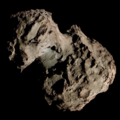 Spitaler's Comet as seen from the Zwicky Transient Facility on 1 December 2022 | |
| Discovery [1] | |
|---|---|
| Discovered by | Rudolf Ferdinand Spitaler |
| Discovery site | Vienna, Austria |
| Discovery date | 17 November 1890 |
| Designations | |
| P/1890 W1, P/1993 U2 | |
| |
| Orbital characteristics [2] [3] | |
| Epoch | 31 March 2024 (JD 2460400.5) |
| Observation arc | 132.41 years |
| Number of observations | 1,022 |
| Aphelion | 5.246 AU |
| Perihelion | 2.143 AU |
| Semi-major axis | 3.694 AU |
| Eccentricity | 0.41994 |
| Orbital period | 7.101 years |
| Inclination | 5.775° |
| 306.66° | |
| Argument of periapsis | 115.63° |
| Mean anomaly | 92.763° |
| Last perihelion | 1 June 2022 |
| Next perihelion | 11 July 2029 [4] |
| TJupiter | 2.929 |
| Earth MOID | 1.138 AU |
| Jupiter MOID | 0.477 AU |
| Physical characteristics | |
Mean radius | 1.15 km (0.71 mi) [5] |
| Comet total magnitude (M1) | 14.7 |
| Comet nuclear magnitude (M2) | 19.6 [6] |
Comet Spitaler is a Jupiter-family comet with a 7.1-year orbit around the Sun. It is the only comet discovered by Austrian astronomer, Rudolf Ferdinand Spitaler.

